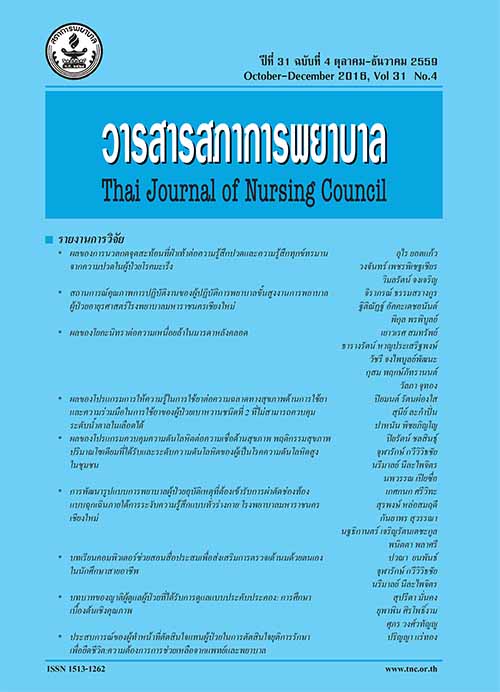ผลของการนวดกดจุดสะท้อนที่ฝ่าเท้าต่อความรู้สึกปวดและความรู้สึก ทุกข์ทรมานจากความปวดในผู้ป่วยโรคมะเร็ง;Reflexology and Its Impact on Cancer Patients’ Perception of Pain and Suffering from the Perception of Pain
Keywords:
การนวดกดจุดสะท้อนที่ฝ่าเท้า, ควำมปวด, ผู้ป่วยโรคมะเร็ง, การวิจัยเชิงทดลอง, reflexology, pain, cancer patients, experimental researchAbstract
บทคัดย่อ: วัตถุประสงค์ของการวิจัย: เพื่อวัดซ้ำถึงประสิทธิผลของกำรนวดกดจุดสะท้อนที่ฝ่าเท้า
ต่อระดับความรู้สึกปวดและความรู้สึกทุกข์ทรมานจากความปวดในผู้ป่วยโรคมะเร็ง
การออกแบบการวิจัย: เป็นกำรวิจัยเชิงทดลองกลุ่มเดี่ยว แบบวัดก่อนและหลังการทดลอง
การดำเนินการวิจัย: กลุ่มตัวอย่ำงเป็นผู้ป่วยโรคมะเร็งที่มีความปวดและไม่อยู่ในระยะลุกลาม
ที่เข้ารับการรักษาที่ศูนย์มะเร็งสุราษฎร์ธานีจำนวน 30 ราย โดยกลุ่มตัวอย่างจะได้รับการสุ่มเพื่อทำการ
นวดฝ่าเท้า 3 แบบ (three-arm randomized, crossover design) คือการนวดแบบติดต่อกัน 3 วัน
การนวดแบบวันเว้นวัน และการนวดหลอก โดยเว้นช่วงห่าง 3 วันเพื่อศึกษาเปรียบเทียบระดับ
ความรู้สึกปวดและระดับความรู้สึกทุกข์ทรมานจากความปวดของผู้ป่วยโรคมะเร็งก่อนและหลัง
การนวด 3 แบบ วัดตัวแปรที่ศึกษา 7 ครั้ง คือก่อนการนวด หลังนวดทันที หลังการนวด 24, 48, 72,
96 และ 120 ชั่วโมง เก็บข้อมูลโดยวิธีปกปิดทางเดียว (single–blind technique) ใช้สถิติบรรยาย
ในการรวิเคราะห์ข้อมูลทั่วไปโดยวิธีแจกแจงความถี่และร้อยละ ใช้คะแนนจำกค่ามัธยฐาน ส่วนเบี่ยงเบน
ควอไทล์ ร่วมกับค่าเฉลี่ยของลำดับในกำรวิเครำะห์ข้อมูลระดับความรู้สึกปวด และข้อมูลระดับ
ความรู้สึกทุกข์ทรมานจากความปวด และใช้สถิติไฟรด์แมน (Friedman’s test) ในกำรเปรียบเทียบ
ระดับคะแนนความรู้สึกปวด และระดับคะแนนความรู้สึกทุกข์ทรมานจากความปวดก่อน และหลัง
การนวด ณ เวลาต่าง ๆ
ผลการวิจัย: ภายหลังได้รับการนวดฝ่าเท้าทั้ง 3 แบบ ระดับคะแนนความรู้สึกปวด และระดับ
คะแนนความรู้สึกทุกข์ทรมานจากความปวดลดลงอย่างมีนัยสำคัญทางสถิติ (p < .001) และภายหลัง
การนวดทันที หลังกำรนวด 24, 48, 72, 96 และ 120 ชั่วโมง การนวดแบบติดต่อกัน 3 วัน มีคะแนน
ระดับความรู้สึกปวดต่ำกว่าการนวดหลอก และการนวดแบบวันเว้นวัน ตามลำดับอย่ำงมีนัยสำคัญทางสถิติ
(p < .05)
ข้อเสนอแนะ: ในทำงปฏิบัติควรนวดแบบวันเว้นวันไปเรื่อย ๆ และควรนวดกับผู้เชี่ยวชำญ
ด้านนการนวดเพื่อคงไว้ซึ่งประสิทธิผลของการนวด และป้องกันผลข้างเคียงจากการนวด
Abstract: Objective: To re-assess the effectiveness and impact of reflexology on cancer
patients’ perception of pain and their suffering from the perception of pain.
Design: Single-group experimental research with a pre-test and a post-test.
Implementation: This study was conducted on 30 patients suffering from pain caused
by non-invasive cancer and receiving cancer treatment at Surat Thani Cancer Centre.
Using a three-armed randomised, crossover design, the researcher engaged the patients in
an experiment involving 3 methods of reflexology: (1) massaging for 3 consecutive days;
(2) massaging on every other day; and (3) one ‘placebo’ massage on every fourth day.
The purpose of the experiment was to compare the patients’ degrees of perception of pain
and suffering from the perception of pain before and after each method of reflexology. The
comparison was based on the outcomes of 7 variables, used to determine the degrees of
the perception of pain and of suffering from the perception of pain (1) before the massage;
(2) immediately after the massage; (3) 24 hours afterwards; (4) 48 hours afterwards;
(5) 72 hours afterwards; (6) 96 hours afterwards; and 120 hours afterwards. Data were
collected using a single-blind technique and analysed using descriptive statistics to identify
the frequency and percentage. The patients’ degrees of the perception of pain and suffering
from the perception of pain were analysed based on the median scores, quartile deviation
scores and the ranking average. The degrees of perception of pain and suffering from
the perception of pain at the 7 different times were compared using Friedman’s test.
Results: After the 3 methods of reflexology, the patients showed a statistically signifcant
reduction in their degrees of perception of pain and suffering from the perception of pain
(p < .001). Based on the measurement taken immediately after each session and at the 24th,
48th, 72nd, 96th and 120th hours after each session, the 3-consecutive-day method was
found to be more effective in reducing the patients’ pain and suffering than were the ‘placebo’
massage and the every-other-day methods respectively, at the level of p < .05.
Recommendations: Despite the experimental advantage of the 3-consecutive-day
method, in practice the every-other-day method is still recommended for an extended
period of time. It is also suggested that a massage specialist be consulted to maintain its
effectiveness and prevent any adverse effects.








